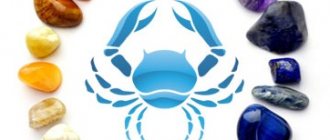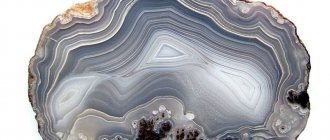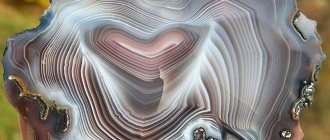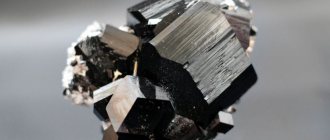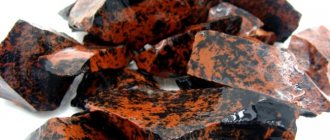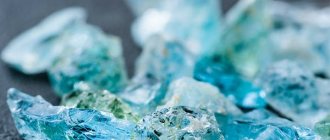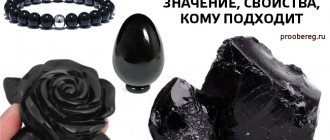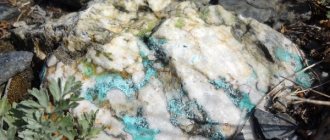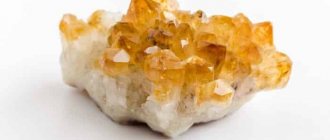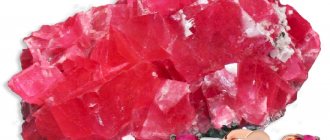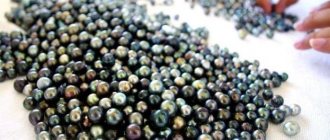Turquoise mining in Afghanistan
Turquoise stone has been known to man since ancient times.
There are many legends and mysterious stories associated with it. Jewelry made from this mineral has been preserved, which was worn by the ancient Greeks and Egyptians, Aztec tribes and Indians of the American continent.
Silver bracelet with turquoise (go to the SUNLIGHT catalog)
History and origin
The history of the gem dates back five thousand years. The sky-colored mineral among ancient peoples symbolized the supreme deity. Other myths claim that turquoise is the bones of people who died from unhappy love.
Turquoise
The oldest objects made from the mineral were discovered in the tombs of the rulers of Ancient Egypt - Queen Zara and Tutankhamun. Turquoise was used to decorate jewelry, amulets or amulets. For example, the warlike Janissaries decorated themselves, weapons and horses to make themselves invulnerable.
The mineral is highly valued in Tibet: here it is a jewel and currency. The properties of turquoise to fade and change color attracted the attention of shamans and sorcerers: they used the stone for fortune telling. The Chinese use it to prove their devotion and loyalty to their significant other.
Turquoise light stones decorated the throne of Boris Godunov, delivered from Turkey: sitting on it, the sovereign calmed down. Ivan the Terrible demonstrated to the ambassadors and entourage how the stone changed color in his hands. The court doctors explained to the king what this meant.
The stone has a special significance for the Muslim world: the Koran is inscribed on blue turquoise.
Turquoise became known to Europeans as the “Turkish stone”; in Russia the Persian name stuck. The mineral acquired its classical name in the 13th century. It is translated differently: “firyuze” is a stone of happiness, “piruz” is a mineral of winners.
Turquoise stone
Turquoise deposits
The turquoise mineral was first discovered in the Sinai Peninsula (Egypt).
Historical sources provide varying information regarding the time period of mining. Some talk about 6000 BC, others talk about 3-4 millennia BC. The Sinai mines were abandoned during the decline of Egypt. Ancient Rome resumed mining of minerals. But then it was suspended again until the Middle Ages. Work is also underway there now.
Where else is turquoise mined:
- USA;
- Brazil;
- Mexico;
- Chile;
- Peru;
- Iran;
- Australia;
- Tanzania.
The first place in production has recently been occupied by the United States. Deposits are located in Arizona, Colorado, Nevada and California.
Physicochemical characteristics
Turquoise is a blue, white or green gem with shades. Color is created by copper or iron. If there is more copper, green shades are obtained, if iron, blue shades are obtained.
Structurally, it is not a crystal, but an agglomerate. Semi-precious or ornamental stone.
| Property | Description |
| Formula | CuAl6(OH)2[PO4]4H2O |
| Color | Blue, light blue, blue-green, green, often with brown spots. |
| Shine | Wax |
| Transparency | Opaque |
| Hardness | 5-6 |
| Cleavage | Perfect/imperfect |
| Kink | Conchoidal, uneven. |
| Density | 2.6-2.8 g/cm³ |
Varieties and colors
The description of the turquoise stone includes three basic colors plus their shades. The color changes over time: a young stone is bluish, but as it ages, it turns green.
Colors
The color range of the mineral is extensive. Colors range from bluish to bright blue or from barely green to olive.
Main colors of turquoise:
Blue
Rare, most refined color. What makes the gem dazzlingly bright is the absence of iron or the predominance of copper. This structure creates the strength of the stone. Therefore, blue turquoise is often used for jewelry. The most popular color is soft blue. Shade options: blue-blue, greenish-blue, light blue.
Turquoise blue
Green
The color is created by significant iron impurities. It has a waxy sheen, sometimes with uneven color and dark veins. This is the color of old or Chinese stone; attribute of elderly people; loved by the people of Tibet and Mongolia. Options: light green, gray-green.
Green turquoise
White
A teenage stone whose maturation, or pigmentation, is just beginning. Due to the porous structure, white turquoise is of no interest to jewelers, but is held in high esteem by collectors.
Bracelet with white turquoise
Varieties
Light-colored specimens with patterns on the surface are often found. They are created by a combination of copper, chromium, manganese and iron.
- Mesh turquoise. Specimens with solid dark (black or brown) veins. Their chaotic intersection creates a harmonious pattern. Other names are lace or cobweb.
- Bone turquoise. Bone or dental phosphate of large fossil mammals, colored turquoise. Used as an imitation of natural stone. Distributed in Siberia, in the south of France. Rarely available for sale, after high-quality processing it becomes a valuable material.
There is a classification by deposits:
- Arizona - an expensive mineral with a dark pattern, mined in the US state of the same name;
- Iranian - pale blue, premium quality;
- Chinese - green turquoise.
The unique ability of turquoise of any kind is to live an almost human life. A stone can be young, mature or old.
Application
Green turquoise is often used as an inlay in jewelry. It is used to create beautiful and original designer products, the likes of which you are unlikely to find. The cut shape is usually cabochon. It is in this form that the color saturation and structure of the mineral can be more expressively reflected.
Particularly popular are jewelry in which green turquoise is not processed, but appears in the form in which nature created it. Usually these are earrings, pendants, beads and rings.
Medicinal properties
The healing properties of the mineral are manifested in the physical and spiritual spheres.
Amulet with turquoise
Physical ailments
The stone has a healing effect in several areas:
- mental problems, insomnia (a gem under the pillow helps);
- headaches, migraines (beads, necklace);
- diseases of the heart, blood vessels (pendant, pendant);
- gastrointestinal disorders, including ulcers (long beads);
- diseases of the liver, gall bladder (long beads);
- stuttering (earrings, pendant);
- colds, sore throat (beads);
- problems with the thyroid gland (pendant).
The gem heals wounds, removes traces of scars, and stops bleeding. A gold bracelet with a stone on the right hand restores immunity.
Not suitable for angry, envious, greedy or depressed people.
Spiritual help
Turquoise harmonizes mood, balances emotions, cleansing and restoring energy:
- Makes a person kinder, helps to get rid of the desire for revenge, teaches to forgive.
- Restores peace between those who have quarreled, helps to understand the cause and eliminate it.
- Helps you cope with thoughts about past sins and not regret anything.
To go through life without doubt, a dark blue rich stone is worn not on the body, but close to it: in a bag or wallet.
Shamballa bracelet with turquoise
A pale blue gem will establish inner harmony.
Health indicator
Even the ancient Mongols determined the state of human health by turquoise. If the stone begins to fade for no reason, the person has an illness or fever. This is not due to magic, but to the natural qualities of the gem. Turquoise reacts to increases in temperature or moisture levels by changing color.
Name compatibility
Turquoise is an extraordinary stone; it especially benefits women with the names:
- Diana will find her true calling, which will bring her joy, peace, harmony in her soul and stability in life.
- Rimma will learn to use her finances rationally, and will also begin to understand people better and make many new friends.
- Irina will become softer and calmer, her mood will improve, apathy and laziness will recede.
- Maya, with the support of the turquoise talisman, will build a brilliant career and realize all her ideas.
- Inna will discover a craving for creativity and enormous talent; the stone will also help her to easily overcome difficulties and not take failures to heart.
By and large, it doesn’t matter what a person’s name is. If he really wants to make friends with turquoise, then she will patronize him. However, the “Turkish stone” will not help negative personalities and people with evil intentions, even if the stars predict perfect compatibility for them.
Magic properties
The magical properties of the stone have been known since the 4th millennium BC. They manifest themselves on the physical and mental levels.
Bracelet with turquoise
Are common
Modern esotericists and sorcerers highlight the following magical properties of natural turquoise:
- Amulet. In the East, children's amulets are made from gemstones. Adults wear a ring or ring: they believe that jewelry will protect them from evil entities and bring good luck.
- Indicator of the body's condition. The stone loses its brightness after the death of the owner: it seems to go out with him. The shine is restored when a new owner is found.
- Relationship marker. A mineral that has changed color signals betrayal of a girlfriend (boyfriend), betrayal of a partner, imminent separation or quarrel.
- Spiritual contact. The gem is able to communicate with the owner at the subconscious level; jewelry and amulets will develop the gift of foresight and attract inspiration.
A ring or ring with turquoise is bought to attract happiness, love, material wealth or spiritual perfection.
However, the magic of the mineral helps only those who pursue good goals and achieve results honestly.
- Leadership. The amulet helps you get along with management, climb the career ladder, and become a boss yourself. Will protect you from mistakes. Greenish turquoise is suitable as a gift for a manager. A stone of this shade brings wealth.
- Guardian of loyalty. If a woman puts a pebble in a man’s pocket or gives a keychain with turquoise, the magic of the stone guarantees strong love. A little thing with a mineral from a loved one will bring success to a girl in matters of the heart and profession. In the Muslim world, jewelry with turquoise is still a mandatory attribute of a bride’s wedding dress.
- Stone of courage. This is a talisman for people in dangerous professions or those who are brave in life.
Bracelet with blue turquoise
Turquoise darkens before bad weather and fades in the hands of a sick person.
Color Specialization
Magical compatibility also depends on the color of the gem:
- light shades - give hope, bring harmony and peace;
- dark colors help to choose a path in life and make decisions; suppress temperament, thirst for power; allow you to adapt to new things and not be afraid of the unknown;
- green - light will smooth out emotions and give confidence in upholding a personal opinion; dark green cannot be worn all the time;
- dark blue - will make the owner patient, self-possessed in any situation;
- pale blue - such turquoise has a special meaning for girls of marriageable age or young women; a stone is required in the attire of Muslim brides;
- blue - guarantees success in business, happiness in the family hearth; how a gift shows the sincerity of the giver;
- blue-green - an attribute of magicians or sorcerers in manipulating the other world, not recommended for ordinary people;
- white is a talisman for extreme sports enthusiasts, a talisman for people in dangerous professions.
The strongest magical properties of turquoise are dark blue, almost blue.
Talismans and amulets of all colors relieve fatigue or stress and help to realistically assess reality.
Interesting Facts
No other stone used by man has left such a mark on the development of civilization. The gem was used by almost all cultures and peoples of the world. The duration of formation of deposits is millions of years. the mineral was the result of a chemical reaction of water with copper and aluminum in rocks.
In the 17th century, every self-respecting gentleman did not go out without decoration on his suit made of this gem.
Unfortunately, recently there has been a depletion of turquoise deposits, and all because it is very popular in the jewelry world. It is precisely because the stone, if not properly cared for, loses its quality and color that it is replaced with a new one soon after use.
The long period of formation of the mineral has caused partial depletion of reserves; some experts argue that the cost of jewelry with the gem may soon rise. Buying a stone today is a good investment, which not everyone knows, the main thing is to protect it from temperature changes, ultraviolet radiation and chemical compounds that can react with turquoise and change its composition, and, accordingly, color.
It is also necessary to remember that in nature the mineral occurs in the form of nodules, growths, and veins, so finding a good sample for a product is not so easy. Large formations are highly valued, and these have become increasingly difficult to find lately.
Who is suitable according to their zodiac sign?
Astrologers are unanimous about which zodiac signs benefit from the gem.
It is believed that turquoise does not suit everyone's zodiac sign.
According to the horoscope, choose a pebble of its color:
- blue - Sagittarius, Aquarius, Gemini;
- green - Scorpio, Taurus;
- white - Pisces, Aries, Virgo.
For the rest of the zodiac sign, a mineral of bluish-gray shades is suitable. According to astrologers, turquoise is contraindicated for Leo: its help is more likely to harm. The pebble may be suitable for the month of birth: February - dark blue stone, March - blue, July - green, August - any.
| Zodiac sign | Compatibility (“+++” – fits perfectly, “+” – can be worn, “-” – strictly contraindicated) |
| Aries | + |
| Taurus | +++ |
| Twins | + |
| Cancer | + |
| a lion | — |
| Virgo | + |
| Scales | + |
| Scorpion | + |
| Sagittarius | +++ |
| Capricorn | + |
| Aquarius | + |
| Fish | + |
(“+++” – fits perfectly, “+” – can be worn, “-” – is strictly contraindicated)
Stone compatibility
Turquoise does not quarrel with minerals belonging to the elements of water and air; their proximity will be neutral.
Turquoise is incompatible with fire gems, as they extinguish its magical and healing powers.
The mineral has ideal compatibility with its fellow earth elements - malachite and jade, jasper and agate, aventurine, eye quartz, and so on. They strengthen and complement each other energetically.
Where is it used?
The only sphere of use of stone is the kingdom of beauty. It is classified as jewelry or decorative.
Jewelry
Turquoise is a universal gem; there is a suitable shade for men and women of any age.
The fragile gemstone is difficult to process, so the impact is minimal. It is turned into a cabochon for rings, rings, earrings, brooches, or left in fancy shapes for beads, bracelets, and pendants.
Bracelet with turquoise
Decor
The mineral is used to decorate tableware, watches, and pens. Small plastics are made from it. The most popular products made from turquoise are scarab beetles. They are most often counterfeited.
Price
The price depends on the properties and purity of the stone. The most expensive is a dense blue specimen without “mesh” or veins, up to $30 per carat (or $150 per gram). Porosity, spotting, patterning or yellowing will reduce the value. The smallest bead costs at least 40 rubles.
Price
The reserves of turquoise in the deposits are practically depleted, so it is quite expensive.
Factors influencing the price:
- origin;
- quality;
- coloring
The cost is reduced due to yellowness, pattern, spotting, porosity.
The price of 1 gram of solid stone is from 120 to 180 $ , that is, approximately 25 $ per carat .
Dense blue samples without veins and “networks” are most valued; their price is up to $30 per carat .
The cheapest jewelry is made from pressed natural turquoise.
Although the most valuable and popular turquoise is its rich “sky” color, there are individual examples of other shades that cost more (for example, Australian apple green or chalk).
Examples of prices in Russian online stores:
- beads - 490 rub. (for 1 piece) ;
- tumbling bracelet with “Turquoise” crumbs — 644 RUR. ;
- earrings— RUB 1,142. ;
- stone (sample) - 1,490 rubles. ;
- beads - 2,004 rub.
How to spot a fake
The ancient Egyptians knew how to counterfeit turquoise. They melted glass, earthenware, and fossils, adding pigments. They were not afraid to put imitations even in the tombs of the pharaohs.
The difference between turquoise and fake
Today they offer plastic, ceramics, bone or glass instead.
It is difficult to visually distinguish a real stone from a fake.
The following signs will help you identify fake turquoise:
- A standard pebble is never larger than half a centimeter.
- Description of turquoise: very dense, massive, opaque, with a matte sheen.
- The surface of the natural mineral is rough, but without cracks or swelling. In glass or earthenware, inclusions and swellings are visible under a magnifying glass. The plastic looks smooth, evenly colored, and is almost weightless.
- Turquoise is easy to scratch with a needle, but the groove will be the same color as the surface. If an unpainted layer is detected, shavings have formed, or the needle jumps off the crystal, this means it is a fake. When scratching earthenware, the needle becomes dull.
- Natural stone is difficult to chip.
- The color of the stone should be the same on the beads and in the hole.
- A hot needle will only turn the natural mineral brown, the plastic will melt, and it will emit a chemical smell.
- If you dip the sample in alcohol and then wipe it, the remaining color on the napkin will indicate a fake.
- Imitation “Neolithic” or “Viennese turquoise” is revealed by hydrochloric acid. It will cause yellow spots to appear. Natural mineral will not react.
There is turquoise on the jewelry market, which occupies an intermediate position between natural stone and imitation:
- Fortified. Porous minerals of medium quality, impregnated with paraffin, fat or epoxy resin. The color remains the same, but the stone becomes stronger.
- Ennobled. Dyed, low-grade turquoise stones are identified by their smooth surface and bright color (usually apple green or pink).
- Restored (or pressed). Substandard powdered or low-grade material, painted and glued.
Jewelry with such stones is affordable; most of them are on the market.
Any inspection should be carried out from the inside of the product so as not to damage the stone. Testing with heat is problematic: natural stone can crack along the veins.
Artificial stone is made in a laboratory. Only an expert can identify nanoturquoise. Jewelry made from natural material is supplied with a quality certificate. The deposits of the stone are depleted, so it is never cheap.
Artificial production of mineral
It is obtained by the reaction of malachite, aqueous alumina oxide and phosphoric acid at 100°. Imitation turquoise was made by compressing or fusing precipitated aluminum phosphate and copper phosphate; also by coloring chalcedony or other materials and glass. The imitation can be reliably determined using an X-ray diffraction pattern of the powder. Melting heat detection and flame coloration can also be used for this purpose. Natural turquoise that is not of good enough color is sometimes subjected to artificial processing to give it the desired shade.
“Artificial turquoise” of many varieties has been produced for about a century. So, in the 19th century. in Austria (in Vienna), and then in France and Great Britain, the so-called “Viennese turquoise” was obtained by pressing aluminum phosphate tinted with copper oleate. The refractive index of “Viennese turquoise” is 1.45; when heated in the flame of a gas burner, it sinteres into black glass, while natural turquoise turns into a dark brown powder. “Neolith” - an imitation of reticulated natural turquoise - was obtained in 1957 in Germany. It is a mixture of beyerite Ca (BiO)2 (CO3) 3 and copper phosphate, impregnated with artificial resins. Dark veins were created by impurities of amorphous Fe compounds. There are imitations obtained by pressing dihydrated aluminum phosphate with copper phosphate, Al(OH)3, Cu(SO4), etc.
Turquoise records. Tajikistan
How to wear and care
This is a sophisticated but democratic gem. Jewelry with it is popular both in a wedding dress and as “baubles”.
Ring with turquoise
How to wear
Blue shades of stone are good with white metals, green ones with yellow ones. The monochrome range is diluted with pearls, amber, garnet, lapis lazuli, aquamarine, and other colored stones.
- Turquoise looks best on light, natural clothing.
- It is undesirable to combine green and blue stones, white and yellow frames in one outfit.
- Light-colored stones should be worn by green-eyed or blue-eyed people; darker and more saturated ones are suitable for brown-eyed people.
A silver frame enhances the healing properties of the mineral; jewelry with gold is a powerful protector of the owner’s immune system.
If you have handicraft skills, you can create something exclusive by embroidering it with turquoise, for example, jeans or a clutch.
Rules of care
Turquoise, as a delicate mineral, requires care, but care is not particularly tedious:
- Do not clean with soap and water, steam or ultrasound. Only dry clean with suede, wool, flannel or other soft cloth.
- If dirt has accumulated, you can wash the jewelry in distilled water without delaying the procedure.
- Proper care eliminates overheating, contact with steam, cosmetics, perfumes (perfume can leave a mark). Contact with cosmetics or household chemicals causes the mineral to turn green or blue. You can restore its color at home using aniline dyes.
Necklace with turquoise
To preserve the richness of the color, turquoise is sometimes smeared with lamb fat.
- Before taking a bath, pool or beach, jewelry is removed.
- To prevent the stone from losing its magical properties or being physically damaged, it is stored separately from other jewelry and metals.
- Jewelry is sometimes taken out of boxes. Turquoise loves light, but will fade in direct sun.
The stone absorbs odors and sweat, changing color.
Legends about the gem
There are many legends created by different peoples of the world, who put forward their own point of view about where the mineral came from. The most famous of them says that turquoise is the only stone on which the life and work of Mohammed, the righteous man who delivered sermons from Allah with his lips, fit.
Another equally famous legend about the gem relates to Napoleon, who presented his future wife with a tiara with diamonds and turquoise. In the first version, the jewelry had 79 diamonds and emeralds, but in the end it was decided to replace the latter with turquoise.

